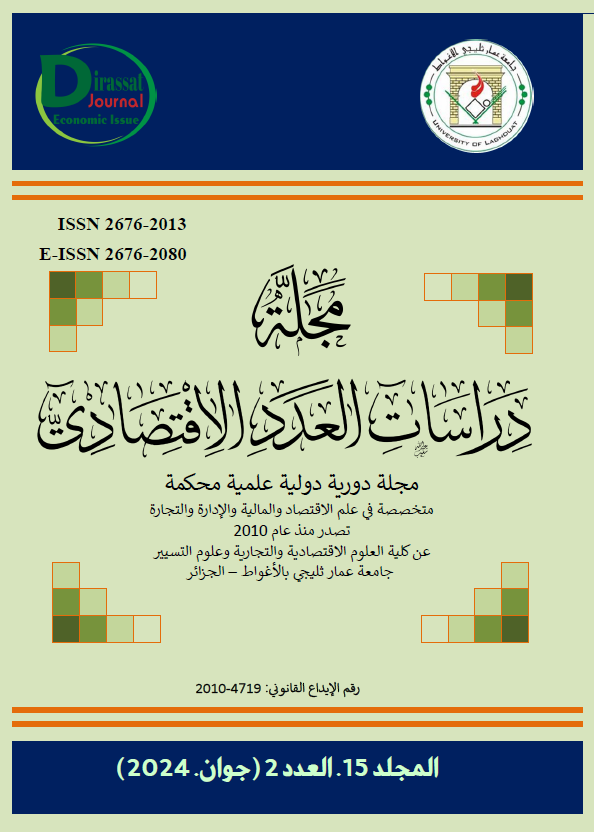Using Artificial Neural Network Model to Forecast the Electricity Consumption in Algeria
Abstract
Recent events, especially the Russian-Ukrainian War have demonstrated the significance of energy resource, which is generally regarded as one of the most fundamental components of global economies and is classified as a strategic component of economic development. In this study, we employed the artificial neural networks to predict the electricity consumption of Algeria using annual data 1980 to 2022. After discussing this method's methodology and the diagnostic phase, the model's Multi-Layer Perceptron neural networks (MLP) were chosen. MLP 3-1-1 was found to be the most effective model. In the forecasting phase, the electricity consumption energy in Algeria was predicted to be 76,83 billion TWh in 2023 and 79,47 billion TWh in 2024, an increase of 3,434%.
Downloads
References
- Al-Thaalabī, s.h.z., and Omran, K.M. (2016). taḥdīd afḍal namūdhaj lltnbwʼ bāsthlāk al-ṭāqah al-kahrabāʼīyah fī al-Minṭaqah al-janūbīyah. Journal of Economics And Administrative Sciences 22 (90), 437-457. https://search.emarefa.net/detail/BIM-699721
- Atrousse, S. (2018). istikhdām manhajīyah jnknz wa-al-shabakāt al-ʻaṣabīyah alāṣṭnāʻyh lltnbʼ bāsthlāk al-ṭāqah al-kahrabāʼīyah bi-Muʼassasat swnlghāz-dirāsah ḥālat Wilāyat Baskarah-, uṭrūḥat duktūrāh fī ʻulūm al-tasyīr, Jāmiʻat Baskarah, al-Jazāʼir. http://thesis.univ-biskra.dz/4485/1/Th%C3%A8se%20Atrous%20Souheila.pdf
- Azadeh, Ghaderi and Gitiforouz. (2006). Estimating Electricity Demand Function in Residential Sector by Fuzzy Regression, IEEE ISIE 2006, July 9-12, Montreal, Quebec, Canada. doi: 10.1109/ISIE.2006.295625.
- Bouznit, Pablo-Romero and Sánchez-Braza. (2018). Residential Electricity Consumption and Economic Growth in Algeria, Energies, 11, 1656. https://doi.org/10.3390/en11071656
- Chekouri, S.M, and Sahed, A. (2022). Forecasting Electricity Consumption In Algeria Using Artificial Neural Networks, مجلة رؤى اقتصادية, 12, 1, p. 247-261. https://www.asjp.cerist.dz/en/article/205040
- Djabari, L. (2016). Ṭuruq ittikhādh al-qarār bi-istikhdām al-dhakāʼ alāṣṭnāʻy : dirāsah muqāranah lltnbʼ bālṭāqh al-kahrabāʼīyah li-Wilāyat Tilimsān bi-istiʻmāl al-Shabakāt al-ʻaṣabīyah alāṣṭnāʻyh, al-ʻUlūm al-iqtiṣādīyah, uṭrūḥat li-nayl shahādat al-Duktūrah takhaṣṣuṣ Buḥūth al-ʻamalīyāt wtsyyr al-muʼassasāt, Jāmiʻat Abī Bakr Balqāyid Tilimsān. http://dspace.univ-tlemcen.dz/bitstream/112/8806/1/sonelgaz-prevision-decision-charge-electrique-intelligence-artificielle-neurones-box-jenkins.Doc.pdf
- Fausett, Laurene. (1994). Fundamentals of neural networks: architectures algorithms, and applications, USA: Prentice-Hall, Inc. https://dl.matlabyar.com/siavash/Neural%20Network/Book/Fausett%20L.-Fundamentals%20of%20Neural%20Networks_%20Architectures,%20Algorithms,%20and%20Applications%20(1994).pdf
- Ghomi, Moeti and Azimi. (2011). Introduction of Neural Network Model and Fuzzy Regression Method for Short Term Load Forecasting in The Center Regional of IRAN, 2011 International Conference on Network and Electronics Engineering IPCSIT vol.11 © IACSIT Press, Singapore.
- Jaromir, Vrbka. (2021). Using Artifical Neural Networks for Timeseries Smoothing and Forecating: Case Studies in Economics, Institute of Technology and Business in Ceske, Volume 979. https://doi.org/10.1007/978-3-030-75649-9
- Kavaklioglu, K, Ceylan, H, Ozturk, H.K, and Canyurt, O.E. (2009). Modeling and prediction of Turkey’s electricity consumption using Artificial Neural Networks, Energy Conversion and Management, Volume 50, Issue 11, Pages 2719-2727, https://doi.org/10.1016/j.enconman.2009.06.016
- Li, Kai, and Tao Zhang. (2018). Forecasting Electricity Consumption Using an Improved Grey Prediction Model, Information 9, no. 8, 204. https://doi.org/10.3390/info9080204
- Madouri, H., and Mékidiche, M. (2017). dirāsah muqāranah bayna bayna al-namādhij al-Ṭawīlah ARFIMA wa-al-shabakāt al-ʻaṣabīyah alāṣṭnāʻyh bāltnbʼ bsʻr ṣarf al-dīnār al-Jazāʼirī,. El-Bahith Review 17 (17), 159-171. https://www.asjp.cerist.dz/en/article/34422
- Panklib, K, Prakasvudhisarn, C, and Khummongkol, D. (2015). Electricity Consumption Forecasting in Thailand Using an Artificial Neural Network and Multiple Linear Regression, Energy Sources, Part B: Economics, Planning, and Policy, 10, 4, 427-434, https://doi.org/10.1080/15567249.2011.559520
- Pereira, F., Lou, B., Pritchett, B. et al. (2018). Toward a universal decoder of linguistic meaning from brain activation. Nat Commun 9, 963. https://doi.org/10.1038/s41467-018-03068-4
- Sahed, A., and Kahoui, H. (2022). althjyn bayna Shabakah dāllah al-Asās alshʻāʻyh Rbfn wa-namādhij Arima fī al-tanabbuʼ bāsthlāk al-kahrabāʼ fī al-Jazāʼir lil-fatrah 1980-2019. Human Resources Development 17 (2), 495-514. https://www.asjp.cerist.dz/en/article/192969
- Sarkar, Rabbani, Khan and Hossain. (2015). Electricity Demand Forecasting of Rajshahi City in Bangladesh Using Fuzzy Linear Regression Model, 2nd Int'l Conf. on Electrical Engineering and Information & Communication Technology (ICEEICT) Jahangirnagar University, Dhaka-1342, Bangladesh, 21-23 May 2015. http://dx.doi.org/10.1109/ICEEICT.2015.7307424
- Scarborough, D., & Somers, M. J. (2006). Neural networks in organizational research: Applying pattern recognition to the analysis of organizational behavior. American Psychological Association. https://doi.org/10.1037/11465-000
- Shah, Ismail, Hasnain Iftikhar, and Sajid Ali. (2020). Modeling and Forecasting Medium-Term Electricity Consumption Using Component Estimation Technique, Forecasting, 2, no. 2, 163-179. https://doi.org/10.3390/forecast2020009
Copyright (c) 2024 Salaheddine SARI-HASSOUN , Mohamed Abdeldjalil NAMANE , Abdelghani MALIOUI

This work is licensed under a Creative Commons Attribution-NonCommercial 4.0 International License.
















